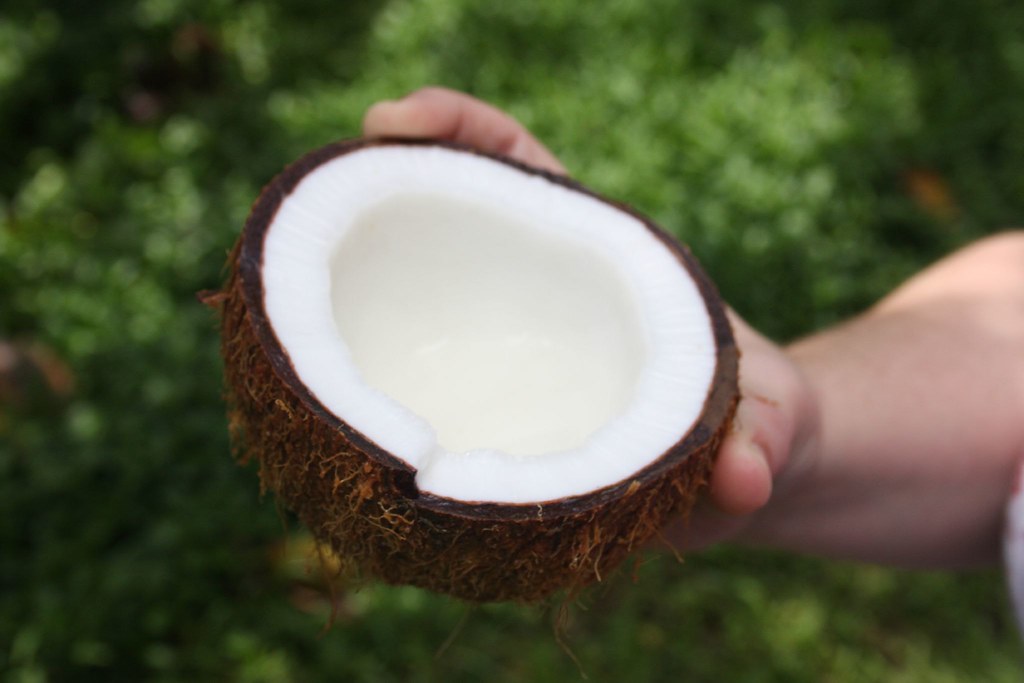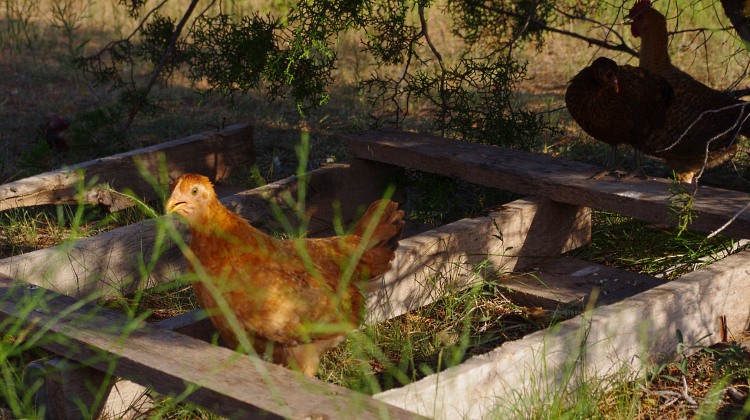Five Foods Worth Buying Non-Local

You may notice that I have given the site a bit of a spring cleaning. Small changes will continue to be made throughout the week, but if you notice something is off, not working, or just looks a little funny please let me know. I hope this new look is more reader friendly and makes your visit here a pleasant one.
Now that farmer’s markets are opening and gardens are being planted I have local eating on my mind. As I plot and plan how to get as many foods locally as possible it occurs to me that some foods are worth buying outside of your area.
We don’t exclusively buy local, though we try to. After thinking about it I came up with this:
If a food is nourishing and their is no local alternative with similar nutrients or flavor then it seems reasonable to outsource it.
5 Foods Worth Buying Non-Local
There are five foods, or food categories, that I can justify buying outside of our local area.
- Coconut Milk and Coconut Oil. A nutrient dense food worth the travel with it’s medium chain lauric acid. Animal fats such as lard or tallow could be used in place for cooking, but I find it helpful for my thyroid and metabolism issues.
- Olive Oil and Avocados. These monounsaturated fats are another fat that could be replaced with local animal fats, but when the budget allows I like a good quality olive oil for salads and avocados ocassionally as a rich treat full of good fats and enzymes. (see sources for a sustainably farmed olive oil)
- Sea Salt and Spices. Sea salt is necessary for flavor and nutrients and spices add nice variety. I could live without cinnamon, cumin, and turmeric, but they add both nutrients and variety to a local diet.
- Seafood and Cod Liver Oil. If there is one food I would purchase more of if our budget increased it would be seafood. The importance of seafood was well known by traditional cultures and we notice a difference when we make it a priority in our diet. Cod liver oil is nice to have as a daily supplement in place of living next to the sea. (see sources for sustainably caught seafood and cod liver oil.)
- Vinegar, Lemons, Coffee, Chocolate, Vanilla. These flavors are worth going the extra mile to purchase. Vinegar and lemons you can most likely source within the United States. The latter three can be bought fair-trade to ensure that the farmers are fairly paid for their work.
Finding the bulk of your animal products and produce locally makes sense in terms of sustainability and nutrition.I don’t think it’s about eating 100% local, but rather making common sense choices. If you can get nourishing alternatives locally, and most of us can, then purchase them instead.
And ultimately growing as much of your own food as possible is the most sustainable choice.
What do you think is worth buying non-local?



This is a good list and I’ve been compiling my own as well. One great source I found for coffee is the Arbor Day Foundations shade coffee… try it and you’ll agree ;o) Now to check your link on cod liver oil as we’re going to start taking this supplement.
Sarah – I will have to look into that coffee, though I only drink decaf now that I’ve finally kicked the habit ;).
I love the new blog design! This is a fabulous list-I totally agree. I’m one of the lucky few who live in So Cal where Avocados grow on trees 🙂
Jana
Jana – So glad you like it. You are fortunate to live where the avocados grow :).
This is a great list! It is common sense, but sometimes it’s hard to see it when you’re overwhelmed with information about organic this, local that etc 🙂
I don’t suppose you know if the organic free trade coffee at Costco is decent or not, do you? Because it’s really yummy and affordable.
Cara – I have never actually been to a Costco (gasp) so I am not sure. I would imagine that if it is truly certified Fair-Trade and Organic then it should be a good option.
What a peaceful new design. Shannon, it looks great!
I’m so glad you wrote this up, it makes me feel better about my coffee habit.
I could never live without spices. If you’ve followed our spice series on Simple Bites, you’ll agree that I’m passionate about the cumin and cinnamon!
Aimee – Yes – cumin and cinnamon are must haves. Thank you for the kind words regarding the new design.
I can really relate to this post. We love eating locally, but there are a few things we purchase from far away- mostly what’s on your list. I enjoyed reading this, thanks.
I like your list and the sentiment behind it – I’m all for buying my produce locally, and I love to support local dairies, cheesemakers, bakers and other food artisans. And there are some things from around the world that I think are well worth buying, and living with the food miles. Life doesn’t have to be all or nothing! Shades of gray are a-ok.
Thanks. I happen to live in Wellington, NZ and am able to get local olive oil, avocados, and lemons. But I like the way you’ve approached your list. I’ve actually subbed raw coconut oil for butter in a number recipes for butter for friends that can’t eat dairy. So nice to hear that it’s also good for me.
Alaina – That’s exactly my point – find nourishing options that grow where you are.
You can make vinegar at home by letting kombucha get really sour—one less thing non-local.
Rita – Good point. I have some super sour kombucha that I may try to use in a vinaigrette.
You can also make vinegar with fruit scraps, 1/4c of honey and 4 liters of water.
Make sure you leave it open with a cloth over it to prevent dust and bugs getting and stir it once and a while, then strain it after about 2 weeks, and leave it to mature for as long as you like, make sure it’s open again with a cloth on it again. If it molds over there isn’t enough air getting to it, just peel the mold off and let it go again. 🙂
Grapes and pears make the best vinegar, banana’s smell HORRIBLE.
QChan – Thanks so much for that tip. I have read of various ways to make vinegar, but your method makes it seem simple enough to tackle. Thanks!
I’ve tried to imagine a life without olive oil…not pretty!
Aaron – Yes, it is hard to imagine.
Thank you for this. When it comes down to it, there are a quite a few things I would never want to give up – chocolate, coffee, and avocados would be at the top of that list!
What about bananas?
Megan – I used to be a banana-buying junkie with 2 bunches per week going into our grocery cart. But then I considered that I can find apples, berries, and other fruits from the U.S. and better yet locally. So we very rarely (maybe a few times per year) buy bananas now. You can probably get some good grapefruits during the winter where you are too, yum!
I pretty much agree with what you have listed, but personally I don’t think I could live a good life without cinnamon or coriander, LOL! I would also add oranges to our list, although I am growing a dwarf lemon tree in my sunroom, and if that goes well, I will try an orange tree too – and my husband enjoys fair-trade, equal exchange organic bananas.
Jenn – I agree, that is why I listed spices with sea salt. I do have hopes of growing some of our own someday, along with citrus.
I love your list–when you wrapped five key elements into the last one, it made me stop scratching my head as to exactly what would NOT be on the list! Absolutely lemons for me!
Jenn, I’m not sure about cinnamon (it’s a tropical relative to the Laurel tree–might work in your sunroom?), but Coriander is so easy to grow in your home garden; it has a special spot in my garden, right next to the basil. Trouble is getting hubby to leave it there long enough to go to seed, since he loves the fresh cilantro leaves chopped in his salsa, on his potatoes, scrambled eggs… or just about anything else he eats!
BTW, I can’t speak for her, but I would think that Shannon would consider cinnamon in her #5 grouping of “flavorings.” We have to “import” bay leaves, too, and I can’t imagine making broth, spaghetti sauce, sloppy joes, chili… etc. without them!
Dani – Yes, that is a good point. When we have enough land I would like to be able to grow my own coriander, cumin, and other seeds.
Our family would have to add pineapples to the list of non-local items. Pineapple is just too darn good to avoid especially since all melons are off the menu due to food allergies (too bad since our area is known for the multitude of melons it produces). Thanks for a great post!
Rachael R – I have never heard of an allergy to melons. That’s too bad.
We thought my sister was allergic to melons for the longest time (cantaloupe in particular) and it turns out she was allergic to the pesticides they sprayed on the skins. As long as we wash the outside of the melons with a good soap and brush (or buy organic), she doesn’t have a problem. She does still avoid them most of the time though – just in case. 🙂
I’ve been living in a tropical place for almost six months and though the change has been hard sometimes, one of the things I’m thankful is that I can buy local coconut and other stuff. Apples and pears and potatoes are very expensive! so avocados :S But my question now is, what un-local to us, but local to the majority is worth the money??
Andrea – Great question. I would imagine you can get a fair amount of fresh seafood where you’re at. So I would focus more on that and less on pastured meats. You can probably also get a lot of fresh fruits and vegetables that have to be shipped here to the U.S. choose those over the potatoes, etc. It would be difficult for me to learn to love coconut as much as I love my grass-fed butter, here, but it would make more sense.
Great list. I agree with all of them, especially all forms of coconut. If I lived in Hawaii…. then I would buy all my coconuts locally 😉
I would like to add any nut/seed to the list. I like to buy my nuts in bulk to save money and it seems that these things are safe when it comes to getting them non-organic and/or non-locally because of the hard outer shell most nuts/seeds provide.
I was thinking about this recently! How timely. I have to agree with your list. And having a 3 year old, I have to add bananas. There’s no going back now!